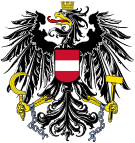You can help expand this article with text translated from the corresponding article in German. (February 2023) Click [show] for important translation instructions.
|
| |||||||||||||||||||||||||||||
All 170 seats in the Constituent Assembly 86 seats needed for a majority | |||||||||||||||||||||||||||||
|---|---|---|---|---|---|---|---|---|---|---|---|---|---|---|---|---|---|---|---|---|---|---|---|---|---|---|---|---|---|
| Turnout | 84.49% | ||||||||||||||||||||||||||||
| |||||||||||||||||||||||||||||
 Results of the election, showing seats won by constituency. Constituencies are shaded according to the first-place party. Representatives were appointed in crosshatched regions (South Tyrol and Lower Styria) where elections did not take place. | |||||||||||||||||||||||||||||
| |||||||||||||||||||||||||||||
| This article is part of a series on the |
| Politics of Austria |
|---|
 |
Constituent Assembly elections were held in Austria on 16 February 1919.[1]
The Social Democratic Workers' Party emerged as the largest party, winning 72 of the 170 seats.[2] The party was largely supported by the working class, whilst farmers and the middle class voted mainly for the anti-Anschluss Christian Social Party.[3] Voter turnout was 84.4%. As Czechoslovakia prevented their eligible population from participating in the election, and Italy and Yugoslavia had gained control of South Tyrol (as a result of the 1915 Treaty of London) and Lower Styria (following border conflicts), respectively, voting only was held in small parts of those eligible territories, and representatives were instead appointed in proportion to parties' total overall vote share.
The first meeting of the assembly was on 4 March 1919. The Sudeten German Social Democrats organised a series of demonstrations in support of their right of self-determination. Across seven cities 54 persons were killed and another 84 wounded by the Czech military and police.[4]
- ^ Nohlen, Dieter; Stöver, Philip (31 May 2010). Elections in Europe: A data handbook. Nomos Verlagsgesellschaft. p. 196. ISBN 978-3-8329-5609-7.
- ^ Graham, Malbone W. (1930). "Foreign Governments and Politics: The Constitutional Crisis in Austria". The American Political Science Review. 24 (1): 144–157. doi:10.2307/1946794. JSTOR 1946794.
- ^ Nohlen & Stöver, p173
- ^ Suppan, Arnold. "Austrians, Czechs, and Sudeten Germans as a Community of Conflict in the Twentieth Century" (PDF). conservancy.umn.edu. Center for Austrian Studies, Minnesota. Retrieved 8 February 2018.




